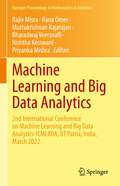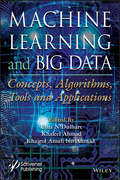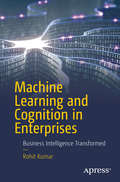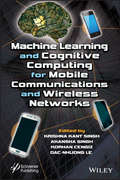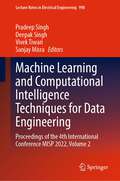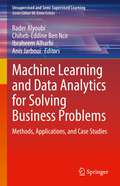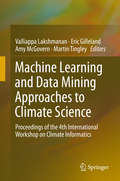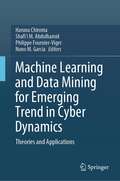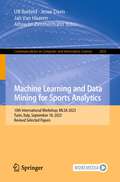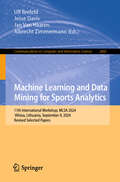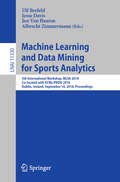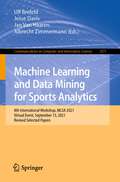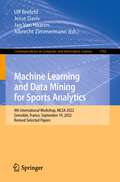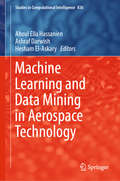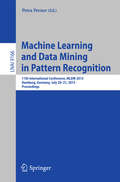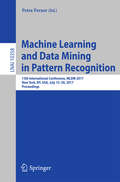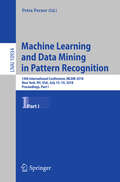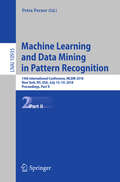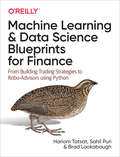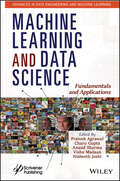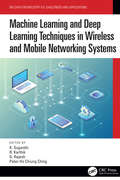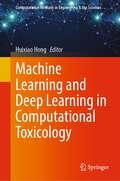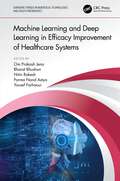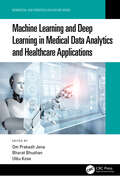- Table View
- List View
Machine Learning and Big Data Analytics: 2nd International Conference on Machine Learning and Big Data Analytics-ICMLBDA, IIT Patna, India, March 2022 (Springer Proceedings in Mathematics & Statistics #401)
by Bharadwaj Veeravalli Rajiv Misra Muttukrishnan Rajarajan Nishtha Kesswani Rana Omer Priyanka MishraThis edited volume on machine learning and big data analytics (Proceedings of ICMLBDA 2022) is intended to be used as a reference book for researchers and professionals to share their research and reports of new technologies and applications in Machine Learning and Big Data Analytics like biometric Recognition Systems, medical diagnosis, industries, telecommunications, AI Petri Nets Model-Based Diagnosis, gaming, stock trading, Intelligent Aerospace Systems, robot control, law, remote sensing and scientific discovery agents and multiagent systems; and natural language and Web intelligence. The intent of this book is to provide awareness of algorithms used for machine learning and big data in the advanced Scientific Technologies, provide a correlation of multidisciplinary areas and become a point of great interest for Data Scientists, systems architects, developers, new researchers and graduate level students. This volume provides cutting-edge research from around the globe on this field. Current status, trends, future directions, opportunities, etc. are discussed, making it friendly for beginners and young researchers.
Machine Learning and Big Data: Concepts, Algorithms, Tools and Applications
by Khaleel Ahmad Uma N. Dulhare Khairol Amali Bin AhmadCurrently many different application areas for Big Data (BD) and Machine Learning (ML) are being explored. These promising application areas for BD/ML are the social sites, search engines, multimedia sharing sites, various stock exchange sites, online gaming, online survey sites and various news sites, and so on. To date, various use-cases for this application area are being researched and developed. Software applications are already being published and used in various settings from education and training to discover useful hidden patterns and other information like customer choices and market trends that can help organizations make more informed and customer-oriented business decisions. Combining BD with ML will provide powerful, largely unexplored application areas that will revolutionize practice in Videos Surveillance, Social Media Services, Email Spam and Malware Filtering, Online Fraud Detection, and so on. It is very important to continuously monitor and understand these effects from safety and societal point of view. Hence, the main purpose of this book is for researchers, software developers and practitioners, academicians and students to showcase novel use-cases and applications, present empirical research results from user-centered qualitative and quantitative experiments of these new applications, and facilitate a discussion forum to explore the latest trends in big data and machine learning by providing algorithms which can be trained to perform interdisciplinary techniques such as statistics, linear algebra, and optimization and also create automated systems that can sift through large volumes of data at high speed to make predictions or decisions without human intervention
Machine Learning and Cognition in Enterprises
by Rohit KumarLearn about the emergence and evolution of IT in the enterprise, see how machine learning is transforming business intelligence, and discover various cognitive artificial intelligence solutions that complement and extend machine learning. In this book, author Rohit Kumar explores the challenges when these concepts intersect in IT systems by presenting detailed descriptions and business scenarios. He starts with the basics of how artificial intelligence started and how cognitive computing developed out of it. He'll explain every aspect of machine learning in detail, the reasons for changing business models to adopt it, and why your business needs it. Along the way you'll become comfortable with the intricacies of natural language processing, predictive analytics, and cognitive computing. Each technique is covered in detail so you can confidently integrate it into your enterprise as it is needed. This practical guide gives you a roadmap for transformin g your business with cognitive computing, giving you the ability to work confidently in an ever-changing enterprise environment. What You'll Learn See the history of AI and how machine learning and cognitive computing evolved Discover why cognitive computing is so important and why your business needs it Master the details of modern AI as it applies to enterprises Map the path ahead in terms of your IT-business integration Avoid common road blocks in the process of adopting cognitive computing in your business Who This Book Is For Business managers and leadership teams.
Machine Learning and Cognitive Computing for Mobile Communications and Wireless Networks
by Dac-Nhuong Le Krishna Kant Singh Korhan Cengiz Akansha SinghCommunication and network technology has witnessed recent rapid development and numerous information services and applications have been developed globally. These technologies have high impact on society and the way people are leading their lives. The advancement in technology has undoubtedly improved the quality of service and user experience yet a lot needs to be still done. Some areas that still need improvement include seamless wide-area coverage, high-capacity hot-spots, low-power massive-connections, low-latency and high-reliability and so on. Thus, it is highly desirable to develop smart technologies for communication to improve the overall services and management of wireless communication. Machine learning and cognitive computing have converged to give some groundbreaking solutions for smart machines. With these two technologies coming together, the machines can acquire the ability to reason similar to the human brain. The research area of machine learning and cognitive computing cover many fields like psychology, biology, signal processing, physics, information theory, mathematics, and statistics that can be used effectively for topology management. Therefore, the utilization of machine learning techniques like data analytics and cognitive power will lead to better performance of communication and wireless systems.
Machine Learning and Computational Intelligence Techniques for Data Engineering: Proceedings of the 4th International Conference MISP 2022, Volume 2 (Lecture Notes in Electrical Engineering #998)
by Sanjay Misra Deepak Singh Vivek Tiwari Pradeep SinghThis book comprises the proceedings of the 4th International Conference on Machine Intelligence and Signal Processing (MISP2022). The contents of this book focus on research advancements in machine intelligence, signal processing, and applications. The book covers the real-time challenges involved while processing big data analytics and stream processing with the integration of smart data computing services and interconnectivity. It also includes the progress in signal processing to process the normal and abnormal categories of real-world signals such as signals generated from IoT devices, smart systems, speech, videos and involves biomedical signal processing: electrocardiogram (ECG), electroencephalogram (EEG), magnetoencephalography (MEG), electromyogram (EMG), etc. This book proves to be a valuable resource for those in academia and industry.
Machine Learning and Data Analytics for Solving Business Problems: Methods, Applications, and Case Studies (Unsupervised and Semi-Supervised Learning)
by Bader Alyoubi Chiheb-Eddine Ben Ncir Ibraheem Alharbi Anis JarbouiThis book presents advances in business computing and data analytics by discussing recent and innovative machine learning methods that have been designed to support decision-making processes. These methods form the theoretical foundations of intelligent management systems, which allows for companies to understand the market environment, to improve the analysis of customer needs, to propose creative personalization of contents, and to design more effective business strategies, products, and services. This book gives an overview of recent methods – such as blockchain, big data, artificial intelligence, and cloud computing – so readers can rapidly explore them and their applications to solve common business challenges. The book aims to empower readers to leverage and develop creative supervised and unsupervised methods to solve business decision-making problems.
Machine Learning and Data Mining Approaches to Climate Science
by Valliappa Lakshmanan Eric Gilleland Amy Mcgovern Martin TingleyThis book presents innovative work in Climate Informatics, a new field that reflects the application of data mining methods to climate science, and shows where this new and fast growing field is headed. Given its interdisciplinary nature, Climate Informatics offers insights, tools and methods that are increasingly needed in order to understand the climate system, an aspect which in turn has become crucial because of the threat of climate change. There has been a veritable explosion in the amount of data produced by satellites, environmental sensors and climate models that monitor, measure and forecast the earth system. In order to meaningfully pursue knowledge discovery on the basis of such voluminous and diverse datasets, it is necessary to apply machine learning methods, and Climate Informatics lies at the intersection of machine learning and climate science. This book grew out of the fourth workshop on Climate Informatics held in Boulder, Colorado in Sep. 2014.
Machine Learning and Data Mining for Emerging Trend in Cyber Dynamics: Theories and Applications
by Philippe Fournier-Viger Nuno M. Garcia Haruna Chiroma Shafi’i M. AbdulhamidThis book addresses theories and empirical procedures for the application of machine learning and data mining to solve problems in cyber dynamics. It explains the fundamentals of cyber dynamics, and presents how these resilient algorithms, strategies, techniques can be used for the development of the cyberspace environment such as: cloud computing services;cyber security; data analytics; and,disruptive technologies like blockchain. The book presents new machine learning and data mining approaches in solving problems in cyber dynamics. Basic concepts, related work reviews, illustrations, empirical results and tables are integrated in each chapter to enable the reader to fully understand the concepts, methodology, and the results presented. The book contains empirical solutions of problems in cyber dynamics ready for industrial applications. The book will be an excellent starting point for postgraduate students and researchers because each chapter is design to have future research directions.
Machine Learning and Data Mining for Sports Analytics: 10th International Workshop, MLSA 2023, Turin, Italy, September 18, 2023, Revised Selected Papers (Communications in Computer and Information Science #2035)
by Jesse Davis Ulf Brefeld Jan Van Haaren Albrecht ZimmermannThis book constitutes the refereed proceedings of the 10th International Workshop on Machine Learning and Data Mining for Sports Analytics, MLSA 2023, held in Turin, Italy, in September 2023.The 16 full papers included in this book were carefully reviewed and selected from 31 submissions. They were organized in topical sections as follows: Football/Soccer, Basketball, Other team sports, Individual sports.
Machine Learning and Data Mining for Sports Analytics: 11th International Workshop, MLSA 2024, Vilnius, Lithuania, September 9, 2024, Revised Selected Papers (Communications in Computer and Information Science #2460)
by Jesse Davis Ulf Brefeld Jan Van Haaren Albrecht ZimmermannThis book constitutes the refereed proceedings of the 11th International Workshop on Machine Learning and Data Mining for Sports Analytics, MLSA 2024, held in Vilnius, Lithuania, on September 9, 2024. The 9 full papers presented in this volume were carefully reviewed and selected from 21 submissions. They are grouped into the following topics: Individual sports; Basketball; Soccer; Other team sports/e-Sports.
Machine Learning and Data Mining for Sports Analytics: 5th International Workshop, MLSA 2018, Co-located with ECML/PKDD 2018, Dublin, Ireland, September 10, 2018, Proceedings (Lecture Notes in Computer Science #11330)
by Jesse Davis Ulf Brefeld Jan Van Haaren Albrecht ZimmermannThis book constitutes the refereed post-conference proceedings of the 5th International Workshop on Machine Learning and Data Mining for Sports Analytics, MLSA 2018, colocated with ECML/PKDD 2018, in Dublin, Ireland, in September 2018.The 12 full papers presented together with 4 challenge papers were carefully reviewed and selected from 24 submissions. The papers present a variety of topics, covering the team sports American football, basketball, ice hockey, and soccer, as well as the individual sports cycling and martial arts. In addition, four challenge papers are included, reporting on how to predict pass receivers in soccer.
Machine Learning and Data Mining for Sports Analytics: 7th International Workshop, MLSA 2020, Co-located with ECML/PKDD 2020, Ghent, Belgium, September 14–18, 2020, Proceedings (Communications in Computer and Information Science #1324)
by Jesse Davis Ulf Brefeld Jan Van Haaren Albrecht ZimmermannThis book constitutes the refereed post-conference proceedings of the 7th International Workshop on Machine Learning and Data Mining for Sports Analytics, MLSA 2020, colocated with ECML/PKDD 2020, in Ghent, Belgium, in September 2020. Due to the COVID-19 pandemic the conference was held online. The 11 papers presented were carefully reviewed and selected from 22 submissions. The papers present a variety of topics within the area of sports analytics, including tactical analysis, outcome predictions, data acquisition, performance optimization, and player evaluation.
Machine Learning and Data Mining for Sports Analytics: 8th International Workshop, MLSA 2021, Virtual Event, September 13, 2021, Revised Selected Papers (Communications in Computer and Information Science #1571)
by Jesse Davis Ulf Brefeld Jan Van Haaren Albrecht ZimmermannThis book constitutes the refereed post-conference proceedings of the 8th International Workshop on Machine Learning and Data Mining for Sports Analytics, MLSA 2021, held as virtual event in September 2021. The 12 full papers and 4 short papers presented were carefully reviewed and selected from 29 submissions. The papers present a variety of topics within the area of sports analytics, including tactical analysis, outcome predictions, data acquisition, performance optimization, and player evaluation.
Machine Learning and Data Mining for Sports Analytics: 9th International Workshop, MLSA 2022, Grenoble, France, September 19, 2022, Revised Selected Papers (Communications in Computer and Information Science #1783)
by Jesse Davis Ulf Brefeld Jan Van Haaren Albrecht ZimmermannThis book constitutes the refereed proceedings of the 9th International Workshop on Machine Learning and Data Mining for Sports Analytics, MLSA 2022, held in Grenoble, France, during September 19, 2022. The 10 full papers included in this book were carefully reviewed and selected from 18 submissions. They were organized in topical sections as follows: Football, Racket sports, Cycling.
Machine Learning and Data Mining in Aerospace Technology (Studies in Computational Intelligence #836)
by Ashraf Darwish Aboul Ella Hassanien Hesham El-AskaryThis book explores the main concepts, algorithms, and techniques of Machine Learning and data mining for aerospace technology. Satellites are the ‘eagle eyes’ that allow us to view massive areas of the Earth simultaneously, and can gather more data, more quickly, than tools on the ground. Consequently, the development of intelligent health monitoring systems for artificial satellites – which can determine satellites’ current status and predict their failure based on telemetry data – is one of the most important current issues in aerospace engineering.This book is divided into three parts, the first of which discusses central problems in the health monitoring of artificial satellites, including tensor-based anomaly detection for satellite telemetry data and machine learning in satellite monitoring, as well as the design, implementation, and validation of satellite simulators. The second part addresses telemetry data analytics and mining problems, while the last part focuses on security issues in telemetry data.
Machine Learning and Data Mining in Pattern Recognition
by Petra PernerThis book constitutes the refereed proceedings of the 11th International Conference on Machine Learning and Data Mining in Pattern Recognition, MLDM 2015, held in Hamburg, Germany in July 2015. The 41 full papers presented were carefully reviewed and selected from 123 submissions. The topics range from theoretical topics for classification, clustering, association rule and pattern mining to specific data mining methods for the different multimedia data types such as image mining, text mining, video mining and Web mining.
Machine Learning and Data Mining in Pattern Recognition
by Petra PernerTheInternationalConferenceonMachineLearningandDataMining(MLDM)is the third meeting in a series of biennial events, which started in 1999, organized by the Institute of Computer Vision and Applied Computer Sciences (IBaI) in Leipzig. MLDM began as a workshop and is now a conference, and has brought the topic of machine learning and data mining to the attention of the research community. Seventy-?ve papers were submitted to the conference this year. The program committeeworkedhardtoselectthemostprogressiveresearchinafairandc- petent review process which led to the acceptance of 33 papers for presentation at the conference. The 33 papers in these proceedings cover a wide variety of topics related to machine learning and data mining. The two invited talks deal with learning in case-based reasoning and with mining for structural data. The contributed papers can be grouped into nine areas: support vector machines; pattern dis- very; decision trees; clustering; classi?cation and retrieval; case-based reasoning; Bayesian models and methods; association rules; and applications. We would like to express our appreciation to the reviewers for their precise andhighlyprofessionalwork. WearegratefultotheGermanScienceFoundation for its support of the Eastern European researchers. We appreciate the help and understanding of the editorial sta? at Springer Verlag, and in particular Alfred Hofmann,whosupportedthepublicationoftheseproceedingsintheLNAIseries. Last, but not least, we wish to thank all the speakers and participants who contributed to the success of the conference.
Machine Learning and Data Mining in Pattern Recognition: 14th International Conference, MLDM 2018, New York, NY, USA, July 15-19, 2018, Proceedings, Part I (Lecture Notes in Computer Science #10934)
by Petra PernerThis two-volume set LNAI 10934 and LNAI 10935 constitutes the refereed proceedings of the 14th International Conference on Machine Learning and Data Mining in Pattern Recognition, MLDM 2018, held in New York, NY, USA in July 2018. The 92 regular papers presented in this two-volume set were carefully reviewed and selected from 298 submissions. The topics range from theoretical topics for classification, clustering, association rule and pattern mining to specific data mining methods for the different multi-media data types such as image mining, text mining, video mining, and Web mining.
Machine Learning and Data Mining in Pattern Recognition: 14th International Conference, MLDM 2018, New York, NY, USA, July 15-19, 2018, Proceedings, Part II (Lecture Notes in Computer Science #10935)
by Petra PernerThis two-volume set LNAI 10934 and LNAI 10935 constitutes the refereed proceedings of the 14th International Conference on Machine Learning and Data Mining in Pattern Recognition, MLDM 2018, held in New York, NY, USA in July 2018. The 92 regular papers presented in this two-volume set were carefully reviewed and selected from 298 submissions. The topics range from theoretical topics for classification, clustering, association rule and pattern mining to specific data mining methods for the different multi-media data types such as image mining, text mining, video mining, and Web mining.
Machine Learning and Data Science Blueprints for Finance: From Building Trading Strategies To Robo-advisors Using Python
by Hariom Tatsat Sahil Puri Brad LookabaughOver the next few decades, machine learning and data science will transform the finance industry. With this practical book, analysts, traders, researchers, and developers will learn how to build machine learning algorithms crucial to the industry. You'll examine ML concepts and over 20 case studies in supervised, unsupervised, and reinforcement learning, along with natural language processing (NLP).Ideal for professionals working at hedge funds, investment and retail banks, and fintech firms, this book also delves deep into portfolio management, algorithmic trading, derivative pricing, fraud detection, asset price prediction, sentiment analysis, and chatbot development. You'll explore real-life problems faced by practitioners and learn scientifically sound solutions supported by code and examples.This book covers:Supervised learning regression-based models for trading strategies, derivative pricing, and portfolio managementSupervised learning classification-based models for credit default risk prediction, fraud detection, and trading strategiesDimensionality reduction techniques with case studies in portfolio management, trading strategy, and yield curve constructionAlgorithms and clustering techniques for finding similar objects, with case studies in trading strategies and portfolio managementReinforcement learning models and techniques used for building trading strategies, derivatives hedging, and portfolio managementNLP techniques using Python libraries such as NLTK and scikit-learn for transforming text into meaningful representations
Machine Learning and Data Science: Fundamentals and Applications
by Charu Gupta Anand Sharma Prateek AgrawalMACHINE LEARNING AND DATA SCIENCE Written and edited by a team of experts in the field, this collection of papers reflects the most up-to-date and comprehensive current state of machine learning and data science for industry, government, and academia. Machine learning (ML) and data science (DS) are very active topics with an extensive scope, both in terms of theory and applications. They have been established as an important emergent scientific field and paradigm driving research evolution in such disciplines as statistics, computing science and intelligence science, and practical transformation in such domains as science, engineering, the public sector, business, social science, and lifestyle. Simultaneously, their applications provide important challenges that can often be addressed only with innovative machine learning and data science algorithms. These algorithms encompass the larger areas of artificial intelligence, data analytics, machine learning, pattern recognition, natural language understanding, and big data manipulation. They also tackle related new scientific challenges, ranging from data capture, creation, storage, retrieval, sharing, analysis, optimization, and visualization, to integrative analysis across heterogeneous and interdependent complex resources for better decision-making, collaboration, and, ultimately, value creation.
Machine Learning and Deep Learning Techniques in Wireless and Mobile Networking Systems (Big Data for Industry 4.0)
by G. Rajesh K. Suganthi R. Karthik Peter Ho Chiung ChingThis book offers the latest advances and results in the fields of Machine Learning and Deep Learning for Wireless Communication and provides positive and critical discussions on the challenges and prospects. It provides a broad spectrum in understanding the improvements in Machine Learning and Deep Learning that are motivating by the specific constraints posed by wireless networking systems. The book offers an extensive overview on intelligent Wireless Communication systems and its underlying technologies, research challenges, solutions, and case studies. It provides information on intelligent wireless communication systems and its models, algorithms and applications. The book is written as a reference that offers the latest technologies and research results to various industry problems.
Machine Learning and Deep Learning in Computational Toxicology (Computational Methods in Engineering & the Sciences)
by Huixiao HongThis book is a collection of machine learning and deep learning algorithms, methods, architectures, and software tools that have been developed and widely applied in predictive toxicology. It compiles a set of recent applications using state-of-the-art machine learning and deep learning techniques in analysis of a variety of toxicological endpoint data. The contents illustrate those machine learning and deep learning algorithms, methods, and software tools and summarise the applications of machine learning and deep learning in predictive toxicology with informative text, figures, and tables that are contributed by the first tier of experts. One of the major features is the case studies of applications of machine learning and deep learning in toxicological research that serve as examples for readers to learn how to apply machine learning and deep learning techniques in predictive toxicology. This book is expected to provide a reference for practical applications of machine learning and deep learning in toxicological research. It is a useful guide for toxicologists, chemists, drug discovery and development researchers, regulatory scientists, government reviewers, and graduate students. The main benefit for the readers is understanding the widely used machine learning and deep learning techniques and gaining practical procedures for applying machine learning and deep learning in predictive toxicology.
Machine Learning and Deep Learning in Efficacy Improvement of Healthcare Systems (Emerging Trends in Biomedical Technologies and Health informatics)
by Om Prakash JenaThe goal of medical informatics is to improve life expectancy, disease diagnosis and quality of life. Medical devices have revolutionized healthcare and have led to the modern age of machine learning, deep learning and Internet of Medical Things (IoMT) with their proliferation, mobility and agility. This book exposes different dimensions of applications for computational intelligence and explains its use in solving various biomedical and healthcare problems in the real world. This book describes the fundamental concepts of machine learning and deep learning techniques in a healthcare system. The aim of this book is to describe how deep learning methods are used to ensure high-quality data processing, medical image and signal analysis and improved healthcare applications. This book also explores different dimensions of computational intelligence applications and illustrates its use in the solution of assorted real-world biomedical and healthcare problems. Furthermore, it provides the healthcare sector with innovative advances in theory, analytical approaches, numerical simulation, statistical analysis, modelling, advanced deployment, case studies, analytical results, computational structuring and significant progress in the field of machine learning and deep learning in healthcare applications. FEATURES Explores different dimensions of computational intelligence applications and illustrates its use in the solution of assorted real-world biomedical and healthcare problems Provides guidance in developing intelligence-based diagnostic systems, efficient models and cost-effective machines Provides the latest research findings, solutions to the concerning issues and relevant theoretical frameworks in the area of machine learning and deep learning for healthcare systems Describes experiences and findings relating to protocol design, prototyping, experimental evaluation, real testbeds and empirical characterization of security and privacy interoperability issues in healthcare applications Explores and illustrates the current and future impacts of pandemics and mitigates risk in healthcare with advanced analytics This book is intended for students, researchers, professionals and policy makers working in the fields of public health and in the healthcare sector. Scientists and IT specialists will also find this book beneficial for research exposure and new ideas in the field of machine learning and deep learning.
Machine Learning and Deep Learning in Medical Data Analytics and Healthcare Applications (Biomedical and Robotics Healthcare)
by Om Prakash JenaMachine Learning and Deep Learning in Medical Data Analytics and Healthcare Applications introduces and explores a variety of schemes designed to empower, enhance, and represent multi-institutional and multi-disciplinary machine learning (ML) and deep learning (DL) research in healthcare paradigms. Serving as a unique compendium of existing and emerging ML/DL paradigms for the healthcare sector, this book demonstrates the depth, breadth, complexity, and diversity of this multi-disciplinary area. It provides a comprehensive overview of ML/DL algorithms and explores the related use cases in enterprises such as computer-aided medical diagnostics, drug discovery and development, medical imaging, automation, robotic surgery, electronic smart records creation, outbreak prediction, medical image analysis, and radiation treatments. This book aims to endow different communities with the innovative advances in theory, analytical results, case studies, numerical simulation, modeling, and computational structuring in the field of ML/DL models for healthcare applications. It will reveal different dimensions of ML/DL applications and will illustrate their use in the solution of assorted real-world biomedical and healthcare problems. Features: Covers the fundamentals of ML and DL in the context of healthcare applications Discusses various data collection approaches from various sources and how to use them in ML/DL models Integrates several aspects of AI-based computational intelligence such as ML and DL from diversified perspectives which describe recent research trends and advanced topics in the field Explores the current and future impacts of pandemics and risk mitigation in healthcare with advanced analytics Emphasizes feature selection as an important step in any accurate model simulation where ML/DL methods are used to help train the system and extract the positive solution implicitly This book is a valuable source of information for researchers, scientists, healthcare professionals, programmers, and graduate-level students interested in understanding the applications of ML/DL in healthcare scenarios. Dr. Om Prakash Jena is an Assistant Professor in the Department of Computer Science, Ravenshaw University, Cuttack, Odisha, India. Dr. Bharat Bhushan is an Assistant Professor of Department of Computer Science and Engineering (CSE) at the School of Engineering and Technology, Sharda University, Greater Noida, India. Dr. Utku Kose is an Associate Professor in Suleyman Demirel University, Turkey.
